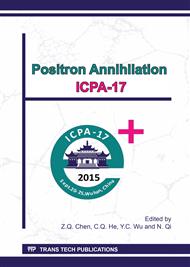[1]
A. K. Roy, S. Bandyopadhyay, S. B. Suresh, et al. Relationship of residual stress to dislocation density in cold-worked martensitic alloy, Mat Sci Eng a-Struct. 416 (2006) 134-138.
DOI: 10.1016/j.msea.2005.09.092
Google Scholar
[2]
T. S. Byun, N. Hashimoto, K. Farrell Deformation mode map of irradiated 316 stainless steel in true stress-dose space, J. Nucl. Mater. 351 (2006) 303-315.
DOI: 10.1016/j.jnucmat.2006.02.033
Google Scholar
[3]
Y. B. Wang, J. C. Ho, Y. Cao, et al. Dislocation density evolution during high pressure torsion of a nanocrystalline Ni-Fe alloy, Appl Phys Lett. 94 (2009) 091911.
DOI: 10.1063/1.3095852
Google Scholar
[4]
H. L. Heinisch, F. Gao, R. J. Kurtz Atomic-scale modeling of interactions of helium, vacancies and helium-vacancy clusters with screw dislocations in alpha-iron, Philos Mag. 90 (2010) 885-895.
DOI: 10.1080/14786430903294932
Google Scholar
[5]
A. Ryazanov, H. Matsui, A. V. Kazaryan Physical mechanisms of helium release during deformation of vanadium alloys doped with helium atoms, J. Nucl. Mater. 271 (1999) 356-359.
DOI: 10.1016/s0022-3115(98)00791-0
Google Scholar
[6]
W. Zielinski, A. A. Abduluyahed, K. J. Kurzydlowski TEM studies of dislocation substructure in 316 austenitic stainless steel strained after annealing in various environments, Mat Sci Eng a-Struct. 249 (1998) 91-96.
DOI: 10.1016/s0921-5093(98)00578-4
Google Scholar
[7]
T. Shintani, Y. Murata Evaluation of the dislocation density and dislocation character in cold rolled Type 304 steel determined by profile analysis of X-ray diffraction, Acta Mater. 59 (2011) 4314-4322.
DOI: 10.1016/j.actamat.2011.03.055
Google Scholar
[8]
J. Baram, M. Rosen Annihilation of Positrons in Fcc Cold-Worked Polycrystals, Physica Status Solidi a-Applied Research. 16 (1973) 263-272.
DOI: 10.1002/pssa.2210160128
Google Scholar
[9]
E. Kuramoto, H. Abe, M. Takenaka, et al. Positron annihilation lifetime study of irradiated and deformed Fe and Ni, J. Nucl. Mater. 239 (1996) 54-60.
DOI: 10.1016/s0022-3115(96)00432-1
Google Scholar
[10]
R. Krause-Rehberg, V. Bondarenko, E. Thiele, et al. Determination of absolute defect concentrations for saturated positron trapping - deformed polycrystalline Ni as a case study, Nucl Instrum Meth B. 240 (2005) 719-725.
DOI: 10.1016/j.nimb.2005.04.130
Google Scholar
[11]
M. Abdelrahman Estimation of dislocation concentration in plastically deformed Al-Li based alloy by positron annihilation, Jpn J Appl Phys 1. 36 (1997) 6530-6532.
DOI: 10.1143/jjap.36.6530
Google Scholar
[12]
J. Kansy Microcomputer program for analysis of positron annihilation lifetime spectra, Nucl Instrum Meth A. 374 (1996) 235-244.
Google Scholar
[13]
M. A. Abdel-Rahman, M. S. Abdallah, E. A. Badawi Study of trapping rate and defect density in AlSi11. 35Mg0. 23 by Positron Annihilation Technique, Surf Rev Lett. 11 (2004) 427-432.
DOI: 10.1142/s0218625x0400630x
Google Scholar


